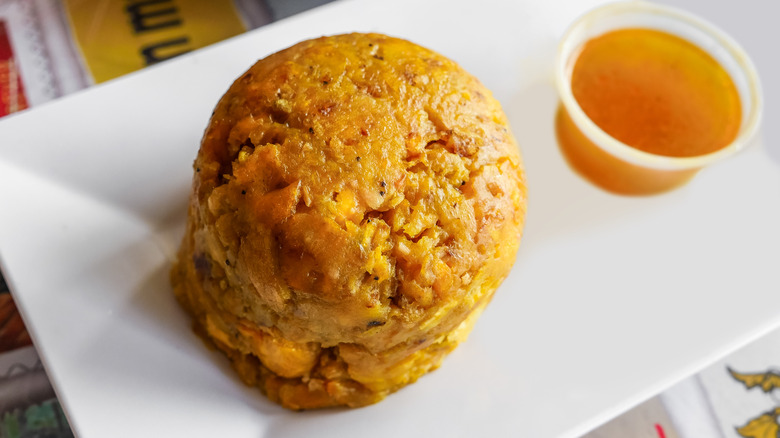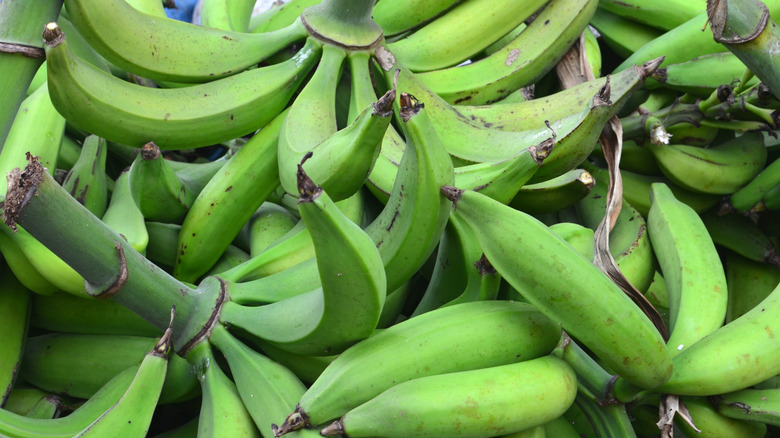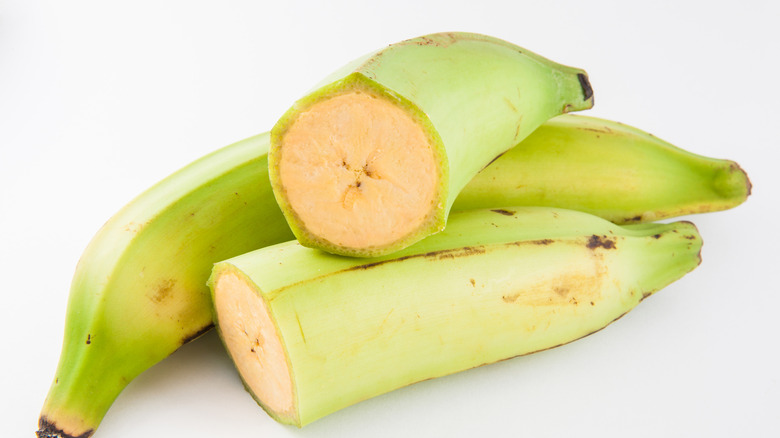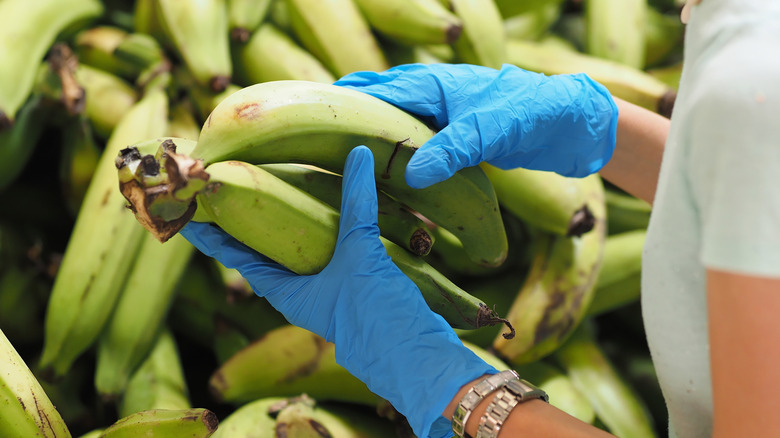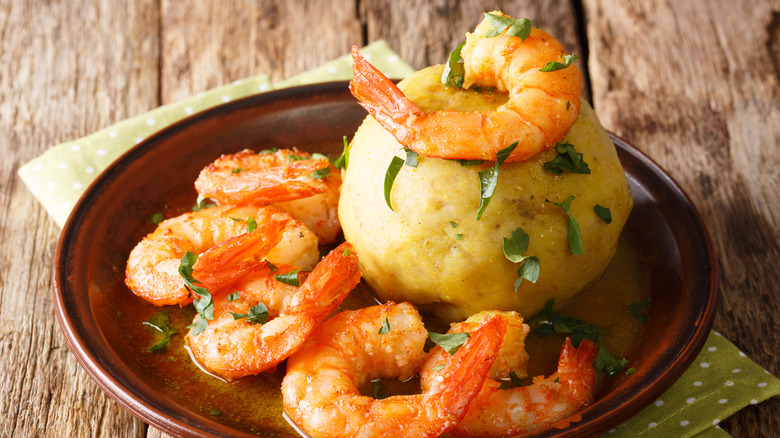What Is Mofongo And What Does It Taste Like?
If you've ever watched any of the "Saturday Night Live" Weekend Update interviews with David Ortiz — in which Keenan Thompson, playing Ortiz, steers every interview question back to a description of his latest "big lunch" — you've almost certainly heard of "mofongo." It's a great detail in a funny sketch series. But what is it, actually?
It turns out that mofongo is a deep-fried, plantain-based dish originally from Puerto Rico. It has come into the national spotlight recently, thanks in part to the success of Mofongo NY, a restaurant concept created by Manolo López, a Puerto Rican chef. Mofongo NY took off in 2014 with a headline-grabbing opening at Smorgasborg — a big name outdoor food market in Brooklyn (via Gothamist). In the years since, López's restaurant concept (now called Mofon•GO) has gone from strength to strength, and mofongo is very much here to stay, with shout outs from everyone from Food Network's Guy Fieri to the New York Times. Read on for the lowdown on this increasingly popular, plantain-based dish.
What exactly is mofongo, anyway?
Mofongo is a savory, plantain-based dish belonging to the Puerto Rican culinary tradition. The main ingredients and the techniques involved in its preparation are rooted in multiple cultures, including those of regions of Africa, Indigenous Puerto Rico, and Spain. A key attribute of mofongo is its versatility. Commonly served as a side, mofongo can easily be supplemented with meat to become a main dish (via AllRecipes).
Mofongo's main ingredient is plantain fruit, an ingredient that, most likely, originally came from Southeast Asia. According to the Encyclopedia Britannica, the plantain (musa paradisiaca) is a kind of banana commonly grown and consumed in tropical areas. Plantains are commonly prepared and consumed while they are still green, and like a milder version of a banana, plantains become mildly sweet when they ripen. They are classified in two main groups: the horn plantain and the French plantain.
How is mofongo made?
The key to making great mofongo is speed: to nail this dish's taste and texture, you will need to "work quickly" (according to the New York Times). A standard batch of mofongo only takes about thirty minutes to prepare — but in that time you'll be completing almost a dozen unique steps.
The broad strokes of the recipe are as follows: essentially you will be chopping up three plantains into coin-shaped rounds, deep-frying them, straining them, mashing them into a paste, and then working that paste into four "baseball-shaped" servings of mofongo. A few details worth noting: your plantains should be green, not brown. Also, you should be frying your plantains in vegetable oil, heated to about 350-375. Fry your plantain rounds in two to three batches, at six to nine minutes per batch. And finally, make sure not to overcrowd the pot. In terms of the kitchen equipment you'll need, make sure you have a pilón, which is a kind of mortar and pestle used to mash the plantains.
Using (and finding) the correct ingredients is key
If this is your first time making mofongo, you may be tempted to use yellow plantains, which resemble dessert bananas. Resist the temptation! Mofongo is a savory dish, and using yellow plantains (which are riper and contain less starch than green plantains) will give you a sweet flavor –– they will also react differently in the pan when it comes to frying. But then again, maybe sweetness is what you're looking for, in which case you might consider using a mixture of green and yellow plantains, giving you a sweet and savory mofongo.
As noted, mofongo is a highly versatile dish, and can be prepared with and served alongside a variety of meats and vegetables.Recipes for the dish often call for chicharrón, or pork cracklings — and this is the version of the mofongo you will find on NYT Cooking and AllRecipes. Manolo Lopez, founder of Mofongo NY, favors a mofongo served with a side of chicken stew (via Bon Appetit). As noted on AllRecipes, mofongo pairs well with both chicken and fish broth, and can be stuffed with everything from octopus salad to garlic shrimp.
Mofongo's flavor (and nutritional value)
While the exact flavor of mofongo will vary depending on what meats and vegetables are mixed into it, mofongo is first and foremost a starch-based fried food — so you can bet on it being rich, savory, and delicious. A chef on AllRecipes describes mofongo as a "guilty pleasure" — and to Monolo Lopez, founder of Mofongo NY, it is "the unofficial national dish of Puerto Rico" and a remedy for "homesickness."
Besides being starchy and deliciously deep-fried, Mofongo is often supplemented with fried pork rinds, giving it a pleasant, salty taste. Fish broth is also commonly used, for a distinctly seafood flavored mofongo.
As a deep-fried, starch-based dish, a little bit of mofongo goes a long way. A single serving of mofongo (two mofongo "patties") has about 86% of your daily value of fat! The plantain dish is also rich in carbs, clocking in at almost 60 grams of carbohydrates per serving (about 20% of your daily value). In terms of vitamins and minerals, mofongo has plenty to offer, with a single serving packing in 40% and 57% of your daily values of Vitamin A and Vitamin C, respectively (via AllRecipes).
Where to buy key ingredients for mofongo
Mofongo's main ingredient is plantains, which can be found in the produce departments of most supermarkets. You can get fresh plantains at retailers like Whole Foods and Stop & Shop — even Walmart has them. Just make sure you're buying green or brown plantains, not yellow ones! Other key ingredients, including chicharrones (pork rinds), and adobo seasoning are also available at Whole Foods
The only other mofongo necessity that you might have trouble tracking down is the pílon — the wooden mortar and pestle, used for mashing and grinding the plantains. As it happens, mashing the plantains by hand, using a pílon, is crucially important. In fact, it's the only way that Mofon•GO's Manolo López (who uses a recipe given to him by his mother), ever makes mofongo (via Bon Appetit). Fortunately, from the looks of it, a version of this kitchen utensil is available for purchase on Amazon.
